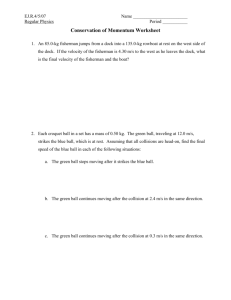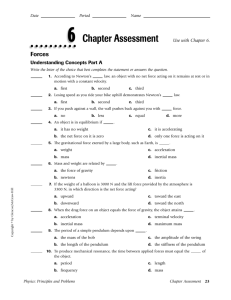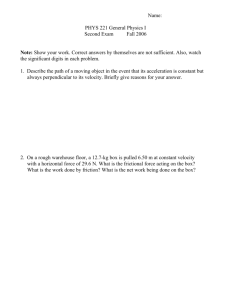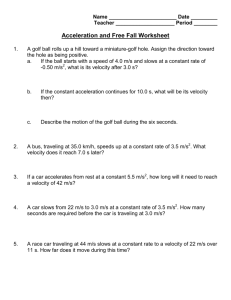Solutions Manual
advertisement
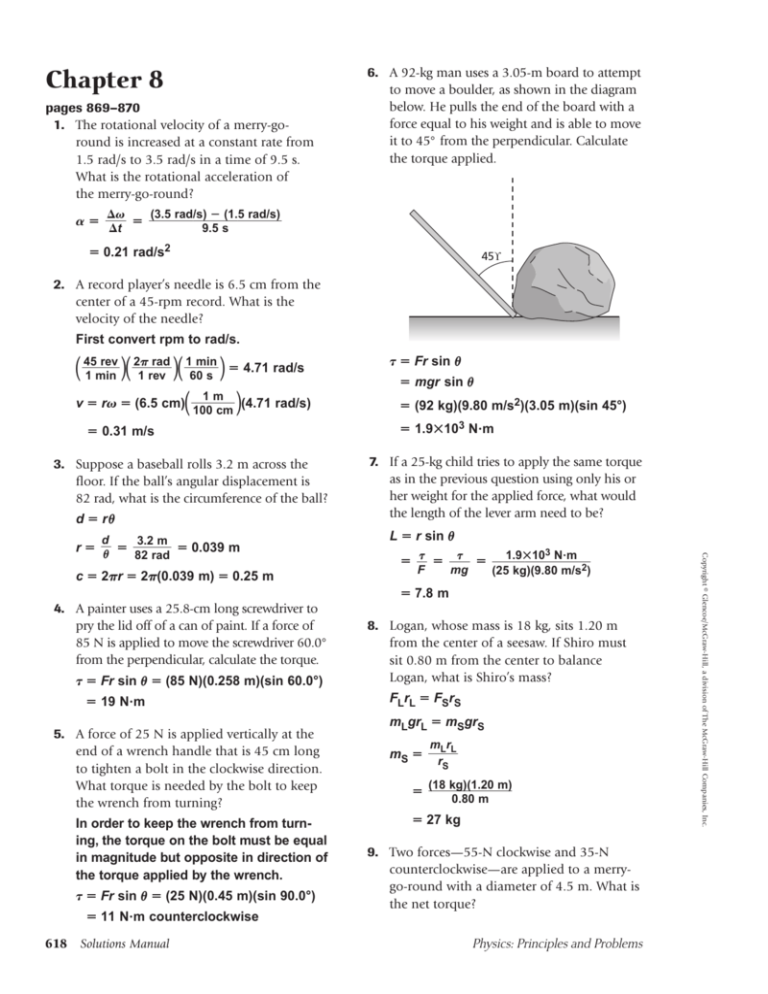
Chapter 8 pages 869–870 1. The rotational velocity of a merry-goround is increased at a constant rate from 1.5 rad/s to 3.5 rad/s in a time of 9.5 s. What is the rotational acceleration of the merry-go-round? 6. A 92-kg man uses a 3.05-m board to attempt to move a boulder, as shown in the diagram below. He pulls the end of the board with a force equal to his weight and is able to move it to 45° from the perpendicular. Calculate the torque applied. (3.5 rad/s) (1.5 rad/s) t 9.5 s 0.21 rad/s2 45° 2. A record player’s needle is 6.5 cm from the center of a 45-rpm record. What is the velocity of the needle? First convert rpm to rad/s. 45 rev 2 rad 1 min 4.71 rad/s 1 min 1 rev 60 s 1m v r (6.5 cm) (4.71 rad/s) 100 cm 0.31 m/s 3. Suppose a baseball rolls 3.2 m across the floor. If the ball’s angular displacement is 82 rad, what is the circumference of the ball? d r 82 rad c 2r 2(0.039 m) 0.25 m 4. A painter uses a 25.8-cm long screwdriver to pry the lid off of a can of paint. If a force of 85 N is applied to move the screwdriver 60.0° from the perpendicular, calculate the torque. Fr sin (85 N)(0.258 m)(sin 60.0°) 19 Nm 5. A force of 25 N is applied vertically at the end of a wrench handle that is 45 cm long to tighten a bolt in the clockwise direction. What torque is needed by the bolt to keep the wrench from turning? In order to keep the wrench from turning, the torque on the bolt must be equal in magnitude but opposite in direction of the torque applied by the wrench. Fr sin (25 N)(0.45 m)(sin 90.0°) 11 Nm counterclockwise 618 Solutions Manual mgr sin (92 kg)(9.80 m/s2)(3.05 m)(sin 45°) 1.9103 Nm 7. If a 25-kg child tries to apply the same torque as in the previous question using only his or her weight for the applied force, what would the length of the lever arm need to be? L r sin 1.9103 Nm 2 F mg (25 kg)(9.80 m/s ) 7.8 m 8. Logan, whose mass is 18 kg, sits 1.20 m from the center of a seesaw. If Shiro must sit 0.80 m from the center to balance Logan, what is Shiro’s mass? FLrL FSrS mLgrL mSgrS m r rS L L mS (18 kg)(1.20 m) 0.80 m 27 kg 9. Two forces—55-N clockwise and 35-N counterclockwise—are applied to a merrygo-round with a diameter of 4.5 m. What is the net torque? Physics: Principles and Problems Copyright © Glencoe/McGraw-Hill, a division of The McGraw-Hill Companies, Inc. d 3.2 m r 0.039 m Fr sin Chapter 8 continued 12. A merry-go-round in the park has a radius of 2.6 m and a moment of inertia of 1773 kgm2. What is the mass of the merry-go-round? m 4.5 1 I mr 2 2 (2)(1773 kgm2) (2.6 m) 2I m 2 2 35 N 55 N r 5.2102 kg The net torque is the sum of the individual torques. net ccw cw I (35 N 55 N) (sin 90.0°) 4.5 m 2 45 Nm Copyright © Glencoe/McGraw-Hill, a division of The McGraw-Hill Companies, Inc. 45 Nm clockwise 10. A student sits on a stool holding a 5.0-kg dumbbell in each hand. He extends his arms such that each dumbbell is 0.60 m from the axis of rotation. The student’s moment of inertia is 5.0 kgm2. What is the moment of inertia of the student and the dumbbells? Isingle dumbbell mr 2 (5.0 kg)(0.60 m)2 Itotal 2Isingle dumbbell I student kgm2 8.6 kgm2 11. A basketball player spins a basketball with a radius of 15 cm on his finger. The mass of the ball is 0.75 kg. What is the moment of inertia about the basketball? 2 2 I mr 2 (0.75 kg)(0.15 m)2 5 5 6.8103 kgm2 (53 N)(2.6 m)(sin 90.0°) 2 1773 kgm 7.8102 rad/s2 14. What is the angular velocity of the merrygo-round described in problems 12 and 13 after 85 s, if it started from rest? f i t t i 0 since it started from rest f t (7.8102 rad/s2)(85 s) 6.6 rad/s 1.8 kgm2 5.0 Fr sin 1 (Fccw Fcw)r sin (2)(1.8 net Fccwr sin Fcwr sin kgm2) 13. The merry-go-round described in the previous problem is pushed with a constant force of 53 N. What is the angular acceleration? 15. An ice-skater with a moment of inertia of 1.1 kgm2 begins to spin with her arms extended. After 25 s, she has an angular velocity of 15 rev/s. What is the net torque acting on the skater? net I I( ) f i t (1.1 kgm2)(15 rev/s 0 rev/s) 255 2 rad rev 4.1 Nm Physics: Principles and Problems Solutions Manual 619 Chapter 8 continued 16. A board that is 1.5 m long is supported in two places. If the force exerted by the first support is 25 N and the forced exerted by the second is 62 N, what is the mass of the board? Fnet F1 F2 (Fg) Since the system is in equilibrium, Fnet 0. 0 F1 F2 Fg Fg F1 F2 mg F1 F2 F1 F2 25 N 62 N m 2 g 9.80 m/s 8.9 kg 17. A child begins to build a house of cards by laying an 8.5-cm-long playing card with a mass of 0.75 g across two other playing cards: support card A and support card B. If support card A is 2.0 cm from the end and exerts a force of 1.5103 N, how far from the end is support card B located? Let the axis of rotation be at the point support card A comes in contact with the top card. Fnet FA FB (Fg) Since the system is in equilibrium, Fnet 0. 0 FA FB Fg FB Fg FA Since the axis of rotation is about support card A, A 0. so net B g The system is in equilibrium, so net 0. 0 B g B g B rBFB and g rgFg rBFB rgFg rgFg rgmg FB mg FA rB 12(0.085 m) 0.020 m(7.5104 kg)(9.80 m/s2) (7.5104 kg)(9.80 m/s2) 1.5103 N 2.8102 m 28 cm 620 Solutions Manual Physics: Principles and Problems Copyright © Glencoe/McGraw-Hill, a division of The McGraw-Hill Companies, Inc. mg FA Chapter 8 continued 18. If support card A in the previous problem was moved so that it now is 2.5 cm from the end, how far from the other end does support card B need to be to reestablish equilibrium? r mg mg FA g rB 12(0.085 m) 0.025 m(7.5104 kg)(9.80 m/s2) (7.5104 kg)(9.80 m/s2) 1.5103 N 2.2102 m Copyright © Glencoe/McGraw-Hill, a division of The McGraw-Hill Companies, Inc. 22 cm Physics: Principles and Problems Solutions Manual 621 Chapter 9 pages 870–871 1. A ball with an initial momentum of 6.00 kgm/s bounces off a wall and travels in the opposite direction with a momentum of 4.00 kgm/s. What is the magnitude of the impulse acting on the ball? Choose the direction away from the wall to be positive. pf 4.00 kgm/s pi 6.00 kgm/s Impulse pf pi (4.00 kgm/s) (6.00 kgm/s) 10.0 kgm/s 2. If the ball in the previous problem interacts with the wall for a time interval of 0.22 s, what is the average force exerted on the wall? Impulse Ft Impulse 10.0 kgm/s 0.22 s F 45 N t 3. A 42.0-kg skateboarder traveling at 1.50 m/s hits a wall and bounces off of it. If the magnitude of the impulse is 150.0 kg·m/s, calculate the final velocity of the skateboarder. Choose the direction away from the wall to be positive. Impulse pf pi mvf (mvi) m(vf vi) 150.0 kgm/s 42.0 kg 1.50 m/s 2.07 m/s 4. A 50.0-g toy car traveling with a velocity of 3.00 m/s due north collides head-on with an 180.0-g fire truck traveling with a velocity of 0.50 m/s due south. The toys stick together after the collision. What are the magnitude and direction of their velocity after the collision? Choose north to be positive. pi pf pci pti pf mcvci mtvti (mc mt)vf m v mv mc mt c ci t ti vf (50.0 g)(3.00 m/s) (180.0 g)(0.50 m/s) 50.0 g 180.0 g 0.26 m/s, due north 622 Solutions Manual Physics: Principles and Problems Copyright © Glencoe/McGraw-Hill, a division of The McGraw-Hill Companies, Inc. Impulse m vf vi Chapter 9 continued 5. A 0.040-kg bullet is fired into a 3.50-kg block of wood, which was initially at rest. The bullet remains embedded within the block of wood after the collision. The bullet and the block of wood move at a velocity of 7.40 m/s. What was the original velocity of the bullet? pi pf pbi pwi pf mbvbi mwvwi (mb mw)vf where vwi 0. Thus, (0.040 kg 3.50 kg)(7.40 m/s) vbi 0.040 kg 6.5102 m/s 6. Ball A, with a mass of 0.20 kg, strikes ball B, with a mass of 0.30 kg. The initial velocity of ball A is 0.95 m/s. Ball B is initially at rest. What are the final speed and direction of ball A and B after the collision if they stick together? pi pf mAvAi (mA mB)vf m v mA mB Copyright © Glencoe/McGraw-Hill, a division of The McGraw-Hill Companies, Inc. A Ai vf (0.20 kg)(0.95 m/s) 0.20 kg 0.30 kg 0.38 m/s in the same direction as ball A’s initial velocity 7. An ice-skater with a mass of 75.0 kg pushes off against a second skater with a mass of 42.0 kg. Both skaters are initially at rest. After the push, the larger skater moves off with a speed of 0.75 m/s eastward. What is the velocity (magnitude and direction) of the smaller skater after the push? pi pf m1vf1 m2vf2 m v m2 1 f1 vf2 (75.0 kg)(0.75 m/s) 42.0 kg 1.3 m/s The second skater moves west with a velocity of 1.3 m/s. 8. Suppose a 55.0-kg ice-skater, who was initially at rest, fires a 2.50-kg gun. The 0.045-kg bullet leaves the gun at a velocity of 565.0 m/s. What is the velocity of the ice-skater after she fires the gun? pi pf 0 pfs pfb (ms mg)vfs mbvfb because the final mass of the skater includes the mass of the gun held by the skater. Then, m v ms mg b fb vfs (0.045 kg)(565.0 m/s) 55.0 kg 2.50 kg 0.44 m/s 9. A 1200-kg cannon is placed at rest on an ice rink. A 95.0-kg cannonball is shot from the cannon. If the cannon recoils at a speed of 6.80 m/s, what is the speed of the cannonball? pi pf Since the cannon and cannonball are at rest before the blast, pi 0.00 kgm/s. So pfc pfb mcvfc mbvfb m v mb c fc vfb (1200 kg)(6.80 m/s) 95.0 kg 86 m/s 10. An 82-kg receiver, moving 0.75 m/s north, is tackled by a 110.0-kg defensive lineman moving 0.15 m/s east. The football players hit the ground together. Calculate their final velocity (magnitude and direction). pri mrvri, y (82 kg)(0.75 m/s) 62 kgm/s north pdi mdvdi, x (110.0 kg)(0.15 m/s) 16 kgm/s, east Physics: Principles and Problems Solutions Manual 623 Chapter 9 continued Law of conservation of momentum states pi pf pf, x pi, x 16 kgm/s pf, y pi, y 62 kgm/s 1 pf (pf, x 2 pf, y 2) 2 1 ((16 kgm/s)2 (62 kgm/s)2) 2 64 kgm/s p 64 kgm/s f vf 82 kg 110.0 kg mr md 0.33 m/s pf, y tan1 pf, x mrvri, y mdvdi, x tan1 (82 kg)(0.75 m/s) (110.0 kg)(0.15 m/s) tan1 75° 11. A 985-kg car traveling south at 29.0 m/s hits a truck traveling 18.0 m/s west, as shown in the figure below. After the collision, the vehicles stick together and travel with a final momentum of 4.0104 kgm/s at an angle of 45°. What is the mass of the truck? 29.0 m/s pf2 pfx 2 pfy2 pf2 pix 2 piy2 pf2 mc2vci2 mt2vti2 pf2 mc2vci2 mt vti2 1 2 p 4.0104 kgm/s (4.0104 kgm/s) (985 kg)2(29.0 m/s)2 (18.0 m/s) 1 2 2 1.6103 kg 624 Solutions Manual Physics: Principles and Problems Copyright © Glencoe/McGraw-Hill, a division of The McGraw-Hill Companies, Inc. 18.0 m/s 45° Chapter 9 continued 12. A 77.0-kg woman is walking 0.10 m/s east in the gym. A man throws a 15.0-kg ball south and accidentally hits the woman. The woman and the ball move together with a velocity of 0.085 m/s. Calculate the direction the woman and the ball move. p pf fx cos1 p pf ix cos1 m v (mw mb)vf w iw cos1 (77.0 kg)(0.10 m/s) cos1 (77.0 kg 15.0 kg)(0.085 m/s) Copyright © Glencoe/McGraw-Hill, a division of The McGraw-Hill Companies, Inc. 1.0101 degrees south of east Physics: Principles and Problems Solutions Manual 625

